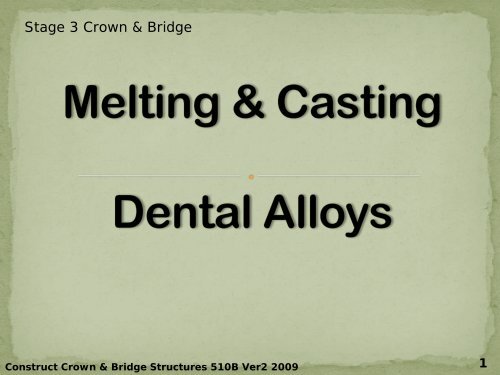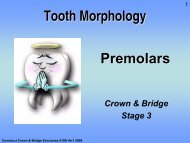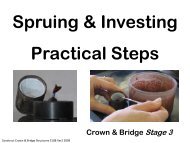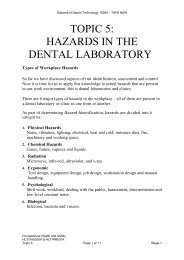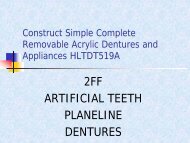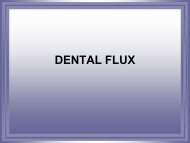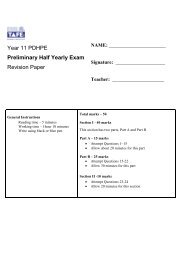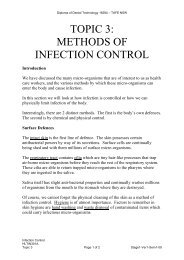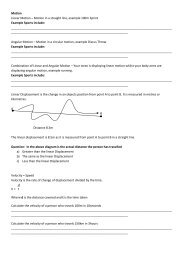Induction Melting Cont'd - Randwick College Wiki
Induction Melting Cont'd - Randwick College Wiki
Induction Melting Cont'd - Randwick College Wiki
- No tags were found...
Create successful ePaper yourself
Turn your PDF publications into a flip-book with our unique Google optimized e-Paper software.
LPG2
At the end of today’s session you should be ableto:-• Describe melting a dental alloy using a torch flame• Identify and describe the zones of a torch flame• Describe the different techniques utilized to meltdental alloys using electricity• Describe the different techniques used to castdental alloys• Identify and describe casting defects3
The dental alloy to be cast can be heatedand melted by the use of:Torch (gas/air)Electric current4
The two most common torch flames used tomelt dental alloys are generated by:Natural gas and oxygenPropane (Liquid Petroleum Gas: LPG) and oxygen6
LPG/Oxygen is the most popular choice,because it produces a hotter flame.Torch melting is done by directing the flameproduced from thegas/oxygencombination atthe dental alloy tobe melted.7
The heat produced from this flame is thenradiated throughout the dental alloy until itis molten and ready to cast.8
Torch melting is generally used withcentrifugal casting machines.9
Flame ZonesThe torch flame can be divided into fourzones:Mixing ZoneCombustion ZoneReducing ZoneOxidizing Zone10
Flame Zones Cont’dThe inner most part of the flame is theMixing Zone. It is cool, colourless andconsists of unburnt gas.11
Flame Zones Cont’dDirectly around this area is a greenish-blueare called the Combustion Zone in whichpartial combustion takes place. This area isan Oxidizing Zone.12
Flame Zones Cont’dThe Reducing Zone is the dim blue areawhich is the hottest area of the flame.13
Flame Zones Cont’dThe outer zone is another Oxidizing Zonein which the final combustion between thegas and the surrounding air occurs.14
Flame Zones Cont’dThe best area to use for melting an alloy ismarked with an ‘X’.15
The three types of electric heating used tomelt dental alloys are:Resistance<strong>Induction</strong>Arc17
Resistance <strong>Melting</strong>All resistance melters use some kind of hightemperature wire (like the wire in lightbulbs) wound into a spiral outside thecrucible.When electricity moves through the wire,the wire offers resistance to the electricityand becomes hot enough that the heatradiates through the crucible to heat themetal.18
Resistance <strong>Melting</strong> Cont’dThis type of melting provides the bestmeans of temperature control and can beused for all types of Crown and Bridgealloys.It also offers a choice of crucibles, carbonfor high gold alloys and ceramic (and flux)for palladium alloys.19
Resistance <strong>Melting</strong> Cont’dResistance melting can be used withcentrifugal or vacuum/pressure castingmachines.20
<strong>Induction</strong> <strong>Melting</strong><strong>Induction</strong> melting works by inducingelectrical eddy currents in the metal.21
<strong>Induction</strong> <strong>Melting</strong> Cont’dThe source is a water-cooled induction coilthat carries an alternating current andsurrounds the crucible.22
<strong>Induction</strong> <strong>Melting</strong> Cont’dThe eddy currents heat the metal eventuallymelting it.This method provides the fastest way ofmelting an alloy but can lead to problemswith temperature control.23
<strong>Induction</strong> <strong>Melting</strong> Cont’dIt requires a pyrometer that is focused onthe alloy to monitor the temperature of themelt.It is used mainly for cobalt-chromium-nickelalloys and titanium alloys.Settings need to be changed for the variousalloys used.24
<strong>Induction</strong> <strong>Melting</strong> Cont’d<strong>Induction</strong> melting can be used withcentrifugal or vacuum/pressure castingmachines.25
Arc <strong>Melting</strong>Arc melting is a process of melting where heatis generated by an electric arc between twoelectrodes and the metal.This electric discharge or arc is created betweenthe electrodes in an argon gas atmosphere.Arc melting is generally not used in dentallaboratory as the machinery is expensive andextremely large.26
The main two casting machines used inDentistry are:CentrifugalVacuum/pressure28
Centrifugal Casting MachineThis machine works on the principle ofcentrifugal force: the metal can beaccelerated outward by rapid spinning.This principle is similar to that used to spinthe water out of wet clothing in the finalcycle of a washing machine.29
Centrifugal Casting Machine Cont’d30
Centrifugal Casting Machine Cont’dWhen the alloy is completely molten, the hotcasting ring is placed behind the cruciblethat contains the molten alloy and thecrucible-ring assembly is spun rapidly,which accelerates the alloy into the castingring into the space previously occupied bythe sprue and wax pattern.31
Vacuum/Pressure Casting MachineThe pressure/vacuum casting machineproduces pressure over the molten alloy.A vacuum is applied to the bottom of themould: the molten alloy is“pushed and sucked”simultaneouslyinto the mould.33
Vacuum/Pressure Casting Machine Cont’dThe vacuum/pressure casting machine firstevacuates the melting chamber to reduceoxidation and thenapplies air pressureuniformly aroundthe casting ring,forcing the alloyinto the mould.34
You should be able to:-• Describe melting a dental alloy using a torch flame• Identify and describe the zones of a torch flame• Describe the different techniques utilized to meltdental alloys using electricity• Describe the different techniques used to castdental alloys• Identify and describe casting defects39


